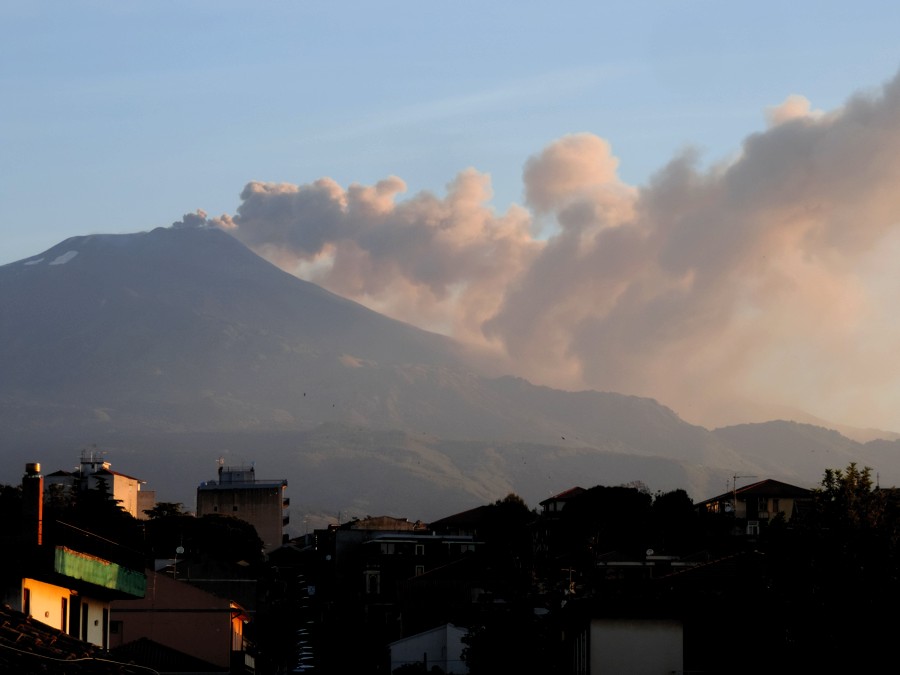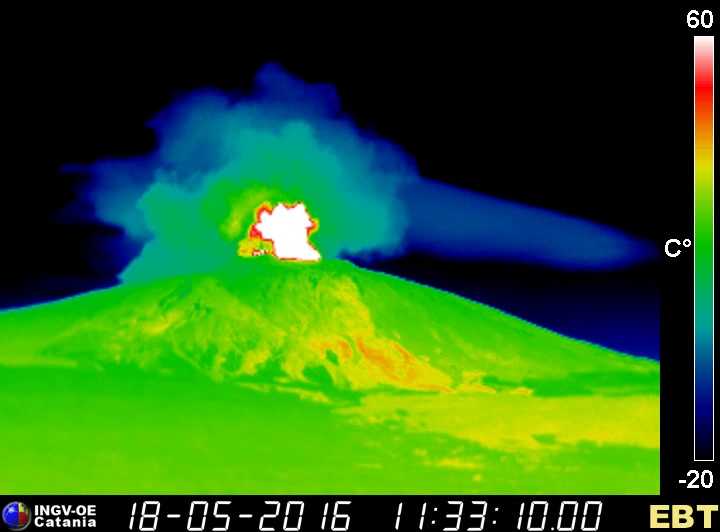
Dalla serata del 17 maggio 2016 è in corso un'intensa attività stromboliana al Cratere di Nord-Est (NEC) dell'Etna, con lancio di bombe incandescenti oltre l'orlo craterico e ricadute di materiale piroclastico sui fianchi del cono. Nel mattino di oggi, 18 maggio, tale attività è stata accompagnata anche da emissioni di cenere vulcanica con un pennacchio diretto verso est-sudest, che si è disperso nell'atmosfera (vedi foto in alto a sinistra, scattata all'alba da Tremestieri Etneo). Si sono osservati anche deboli bagliori in corrispondenza della bocca del 25 novembre 2015 sull'alto fianco orientale del Nuovo Cratere di Sud-Est (NSEC). L'ampiezza del tremore vulcanico è rimasta elevata, mantenendo i valori raggiunti nella serata del giorno precedente. In tarda mattinata, un clinometro posto a Punta Lucia, a quasi 3000 m di quota e a circa 1 km a nord-ovest del NEC, ha registrato una rapida inflazione (rigonfiamento) dell'area sommitale.

Poco dopo le 12:50 (ore locali) del 18 maggio 2016, i sistemi di sorveglianza visiva e termica dell'INGV-OE hanno registrato l'inizio di attività eruttiva alla Voragine (VOR), che in pochi minuti ha preso il carattere di fontana di lava pulsante. Allo stesso tempo è diminuita l'attività stromboliana del NEC passando ad emissione di cenere scura, per poi cessare. L'immagine in basso a sinistra mostra un frame catturato dalla telecamera termica a Bronte (EBT), circa 45 minuti dopo l'inizio dell'attività della VOR. Con l'inizio dell'attività parossistica, si è registrato un repentino aumento dell'ampiezza del tremore vulcanico, la cui sorgente si è spostata dal NEC verso la VOR. Dalla Voragine si è alzato un pennacchio di cenere piegato dal vento verso est-sudest, raggiungendo un'altezza di 3000-3500 m sopra la cima dell'Etna. Nel pomeriggio è iniziato un trabocco di lava dall'orlo occidentale della depressione craterica Voragine-Bocca Nuova, alimentando un modesto flusso lavico diretto verso ovest e limitato all'area sommitale.
Nel momento di pubblicazione del presente aggiornamento sta continuando l'attività di fontana di lava alla VOR. L'attività eruttiva viene seguita costantemente attraverso i sistemi di sorveglianza visiva, termica, sismica e delle deformazioni del suolo.
ETNA UPDATE, 18 MAY 2016, 13:45 UTC
Since the evening of 17 May 2016, there has been an intense Strombolian activity at Etna's Northeast Crater (NEC), with ejection of incandescent bombs above the crater rim and fall of pyroclastics over the flanks of the cone. This morning, 18 May, this activity was also accmpanied by emission of volcanic ash forming a plume that was blown eastward by the wind and rapidly dispersed in the atmosphere (see photo at top left, taken from Tremestieri Etneo at daybreak). There were also weak glows at the 25 November 2015 vent on the upper east flank of the New Southeast Crater (NSEC). The volcanic tremor amplitude remained elevated at values similar to those reached on the evening before. On the late forenoon, a clinometer installed at Punta Lucia, at nearly 3000 m elevation and about 1 km northwest of the NEC, recorded rapid inflation (swelling) of the summit area.
Shortly after 12:50 local time on 18 May 2016, the visual and thermal surveillance cameras of the INGV-OE recorded the onset of eruptive activity at the Voragine (VOR), which in just a few minutes evolved into a pulsating lava fountain. At the same time, the Strombolian activity at the NEC diminished and passed into emission of dark ash, and finally ended. The image at lower left is a frame captured by the thermal monitoring camera at Bronte (EBT), about 45 minutes after the onset of the activity at the VOR. With the beginning of paroxysmal activity, the volcanic tremor amplitude showed a rapid increase, and its source migrated from a position below the NEC toward the VOR. From the Voragine an ash plume rose to 3000-3500 m above the summit and was blown by the wind to east-southeast. During the afternoon lava started to overflow from the western rim of the Voragine-Bocca Nuova depression, feeding a minor lava flow toward west, and limited to the summit area.
At the time this update is being published, lava fountaining is continuing at the VOR. The eruptive activity is monitored continuously by the systems of video and thermal cameras, seismic stations and ground deformation.



